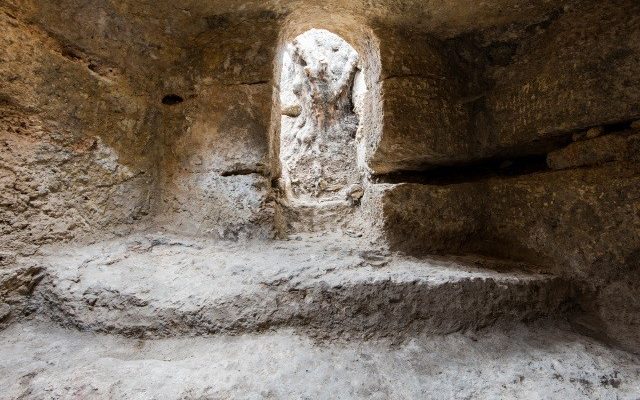Israeli high school students helped uncover a 2000-year-old town dating back to the Second Temple period.
Israeli 11th-graders from a Jerusalem high school recently helped uncover a 2000-year-old town with an impressive array of ritual baths and underground systems used by rebels during the Bar Kokhba Revolt.
The 240 students were working in an original and rewarding way to reduce travel costs for a heritage trip to Poland. They spent an entire week on archaeological excavations in Ramat Beit Shemesh, far from their computers and air-conditioned classrooms.
In recent months, they discovered the remains of a Jewish town dating to the Second Temple period.
As in many other instances in Israel, the findings were chanced upon while conducting excavations prior to the building of a new residential neighborhood.
The town, whose ancient name is unknown, has so far yielded eight ritual baths, cisterns and hiding refuges, along with rock-hewn industrial installations. The houses themselves have not survived and their stones were taken to construct buildings in later periods.
“The town’s extraordinary significance lies in its imposing array of private ritual baths, which were incorporated in the residential buildings,” Sarah Hirshberg, Shua Kisilevitz and Sarah Levevi-Eilat, excavation directors on behalf of the Israel Antiquities Authority (IAA), explained in a statement. “Each household had its own ritual bath and a cistern. Some of the baths uncovered are simple and others are more complex and include an Otzar, or collecting basin, into which the rainwater would drain. It is interesting to note that the local inhabitants adhered strictly to the rules regarding [ritual] purity and impurity.”
Underneath the dwellings and rock-hewn installations, another surprising discovery was unearthed, dating back to the Bar Kokhba Revolt against the Romans (130-135 CE)—a winding labyrinth of hiding refuges connected to sophisticated and elaborate complexes.
In some of the underground complexes, the rebels breached a cistern to provide those in hiding with access to water. One of the caves also yielded complete ceramic jars and cooking pots that were probably used by the rebels. The finds show that the town continued to exist even after the destruction of Jerusalem by the Romans in 70 CE.
Connecting the Past, Present and Future
“This unique project, which connects the country’s past and Israel’s heritage with Holocaust studies and the journey to Poland, provides students with an educational experience in which they are exploring and investigating,” said Dafna Menashe Baruch, principal of Boyer High School, which these students attend.
She said that by stepping outside the classroom and working in the field on an archaeological dig, students are exposed to many different worlds of knowledge, a “valuable educational program that connects the past with the present”.
“It’s fantastic that we, Israeli students in the 21st century, are getting the opportunity to find out about the country and are unearthing a Jewish settlement from 2000 years ago with our own hands,” said student Shelly Kozlovich. “With the money we’re making, we’ll pay for our trip to Poland and learn there about the Holocaust – an event that had a huge influence on Israel’s establishment. It’s a great way of closing a circle.”
The IAA intends to preserve the site and develop an archaeological park in the heart of the new neighborhood.
By: Aryeh Savir, World Israel News




